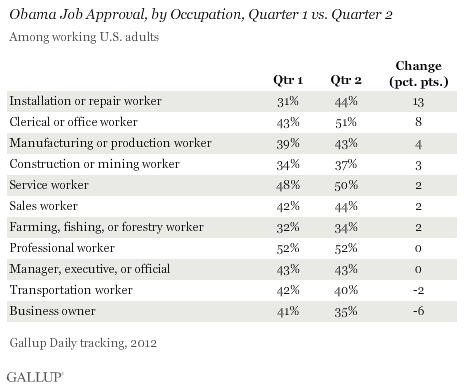WASHINGTON, D.C. -- U.S. business owners' approval of President Barack Obama fell in the second quarter of 2012 to 35%, essentially tying farmers and fishers for the lowest approval among major occupational groups. Overall, professional workers remain the most approving, at 52%.

The findings are based on 25,464 interviews conducted with working U.S. adults in Gallup Daily tracking during the second quarter of 2012. Gallup asks employed adults to describe the work they do and then codes each respondent into one of 11 job categories.
Obama's job approval ratings by occupational group clearly relate to election preferences. Gallup previously found that Obama does best compared with likely Republican presidential nominee Mitt Romney among voters who are professionals and service workers. Romney does best among voters who work in farming and fishing or construction, or are business owners.
In the overall average for the second quarter of 2012, 47% of working Americans approved of the job Obama is doing as president, and 47% disapproved. This is slightly improved from 45% approval and 48% disapproval in the first quarter.
Across occupational groups, installation and repair workers, as well as clerical and office workers, became significantly more approving of Obama in the second quarter. Business owners were the sole group that became significantly less approving, with their second-quarter approval of 35% reflecting a decline from 41% in the first quarter.

While there are too few respondents in some occupational groups to report their approval ratings by month, the internal data suggest the decline in business owners' approval of Obama came for the most part between March and April, with approval holding at a lower rate since then. The data precede Obama's much-discussed July 13 comments that small-business owners have had help from others to achieve success. Thus it is not yet clear whether those comments have led to further deterioration in Obama's standing among small-business owners.
Implications
With approval of President Obama trending somewhat higher, but remaining below the historical threshold for re-election, approval among different groups provides a lens of his strengths and weaknesses. While Obama has been able to maintain or increase his approval rating among most occupational groups so far this election year, he has lost ground among business owners.
Although business owners represent just a small subset of the U.S. population, they are of course a critical component of the economy and overall economic optimism in the country. If business owners become more positive about Obama and his plans for the economy, that could potentially boost his approval ratings and broader U.S. economic confidence closer to the levels necessary for him to be well positioned for re-election. Conversely, further deterioration in his approval rating among business owners could certainly add to the perception that Obama is not doing enough to bolster small businesses in the country.
See page 2 for a complete description of each occupational group and for sample sizes.
Survey Methods
Results are based on telephone interviews conducted as part of the Gallup Daily tracking April 1-June 30, 2012, with a random sample of 25,464 employed adults, aged 18 and older, living in all 50 U.S. states and the District of Columbia.
For results based on the total sample of working U.S. adults, one can say with 95% confidence that the maximum margin of sampling error is ±1 percentage point.
For results based on the total sample of each occupational group, one can say with 95% confidence that the maximum margin of sampling error ranges from ±2 to ±6 percentage points.
Interviews are conducted with respondents on landline telephones and cellular phones, with interviews conducted in Spanish for respondents who are primarily Spanish-speaking. Each sample includes a minimum quota of 400 cell phone respondents and 600 landline respondents per 1,000 national adults, with additional minimum quotas among landline respondents by region. Landline telephone numbers are chosen at random among listed telephone numbers. Cell phone numbers are selected using random-digit-dial methods. Landline respondents are chosen at random within each household on the basis of which member had the most recent birthday.
Samples are weighted by gender, age, race, Hispanic ethnicity, education, region, adults in the household, and phone status (cell phone only/landline only/both, cell phone mostly, and having an unlisted landline number). Demographic weighting targets are based on the March 2011 Current Population Survey figures for the aged 18 and older non-institutionalized population living in U.S. telephone households. All reported margins of sampling error include the computed design effects for weighting and sample design.
In addition to sampling error, question wording and practical difficulties in conducting surveys can introduce error or bias into the findings of public opinion polls.
For more details on Gallup's polling methodology, visit www.gallup.com.

